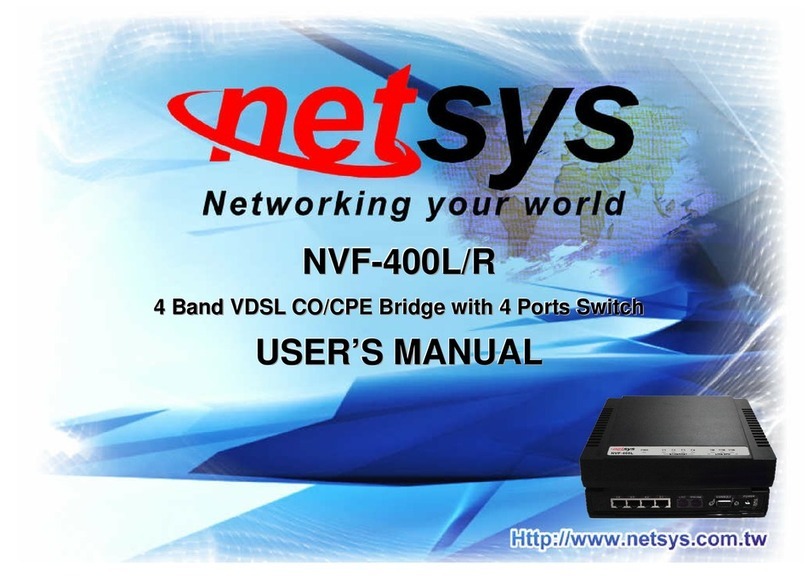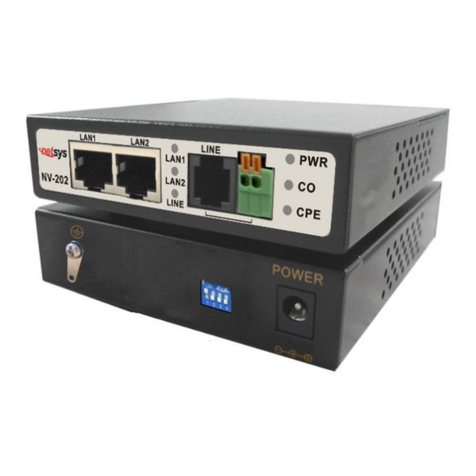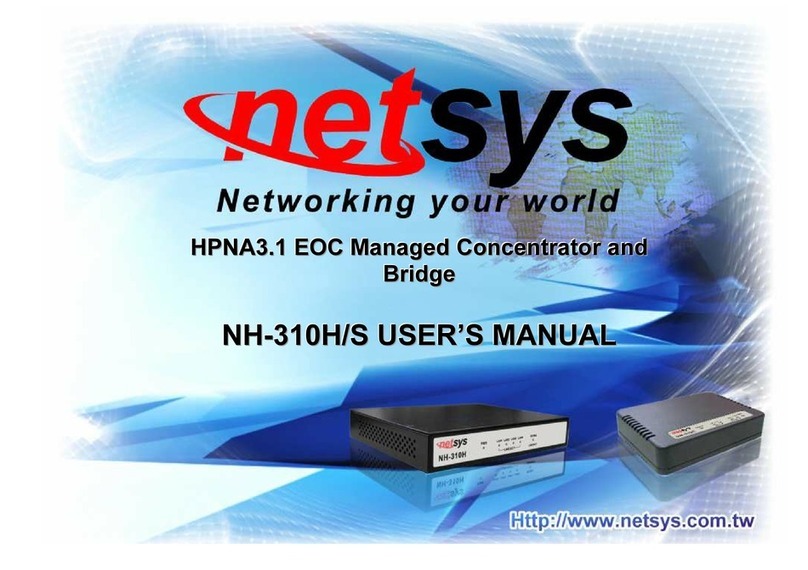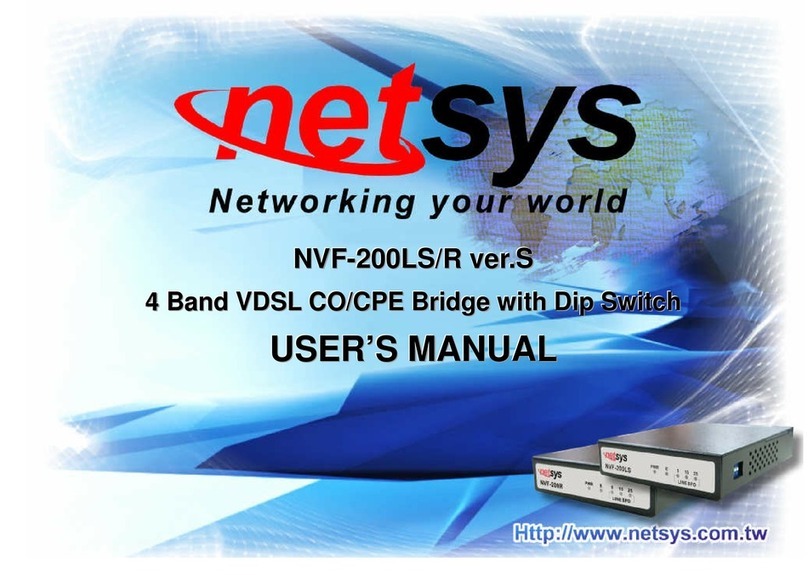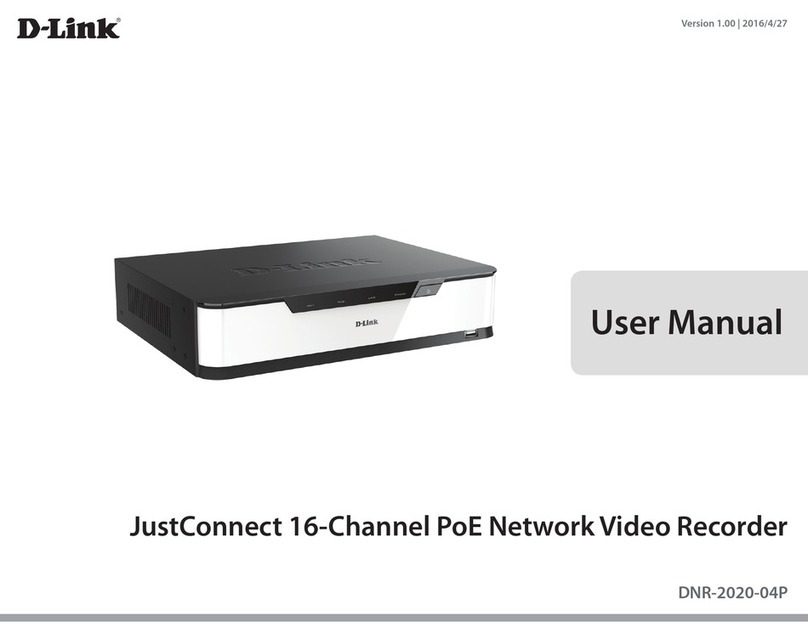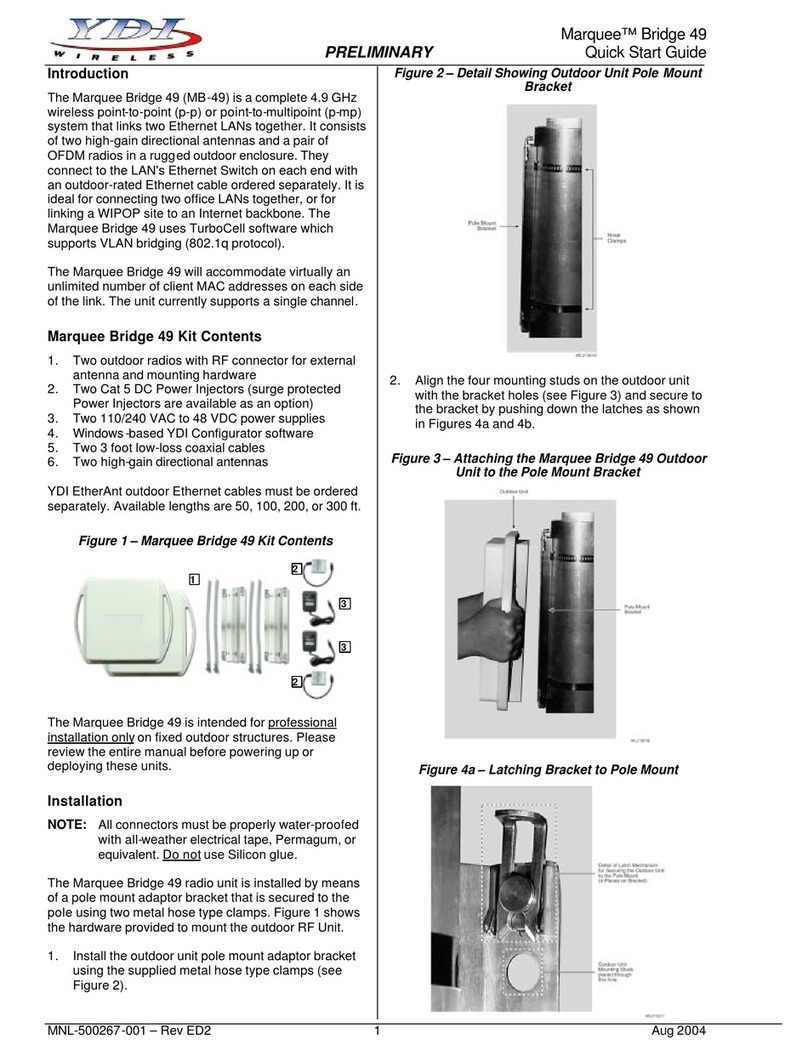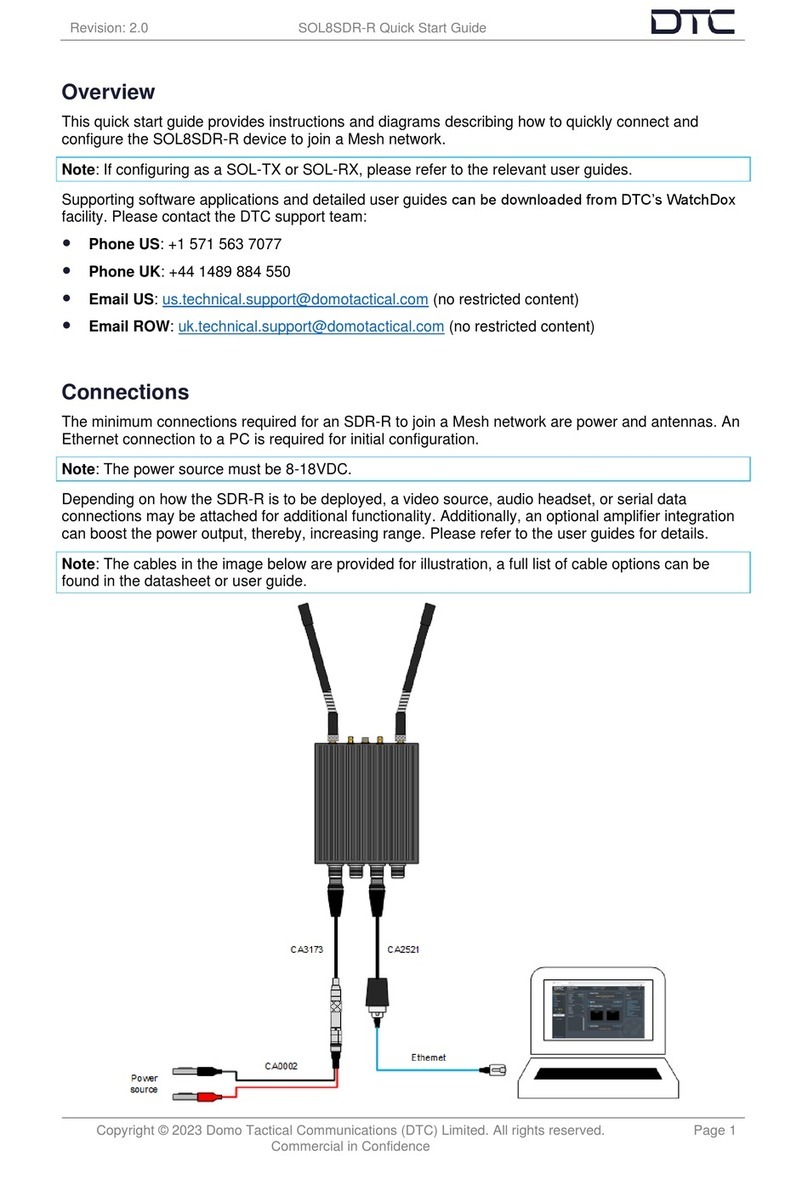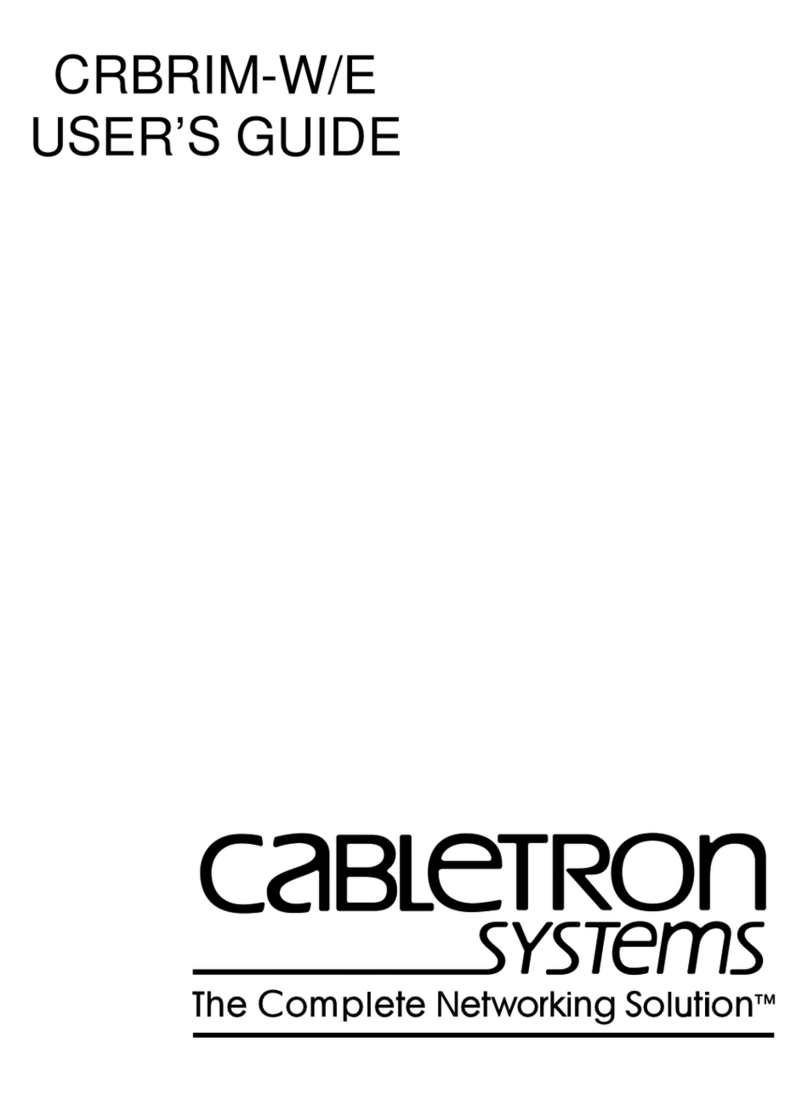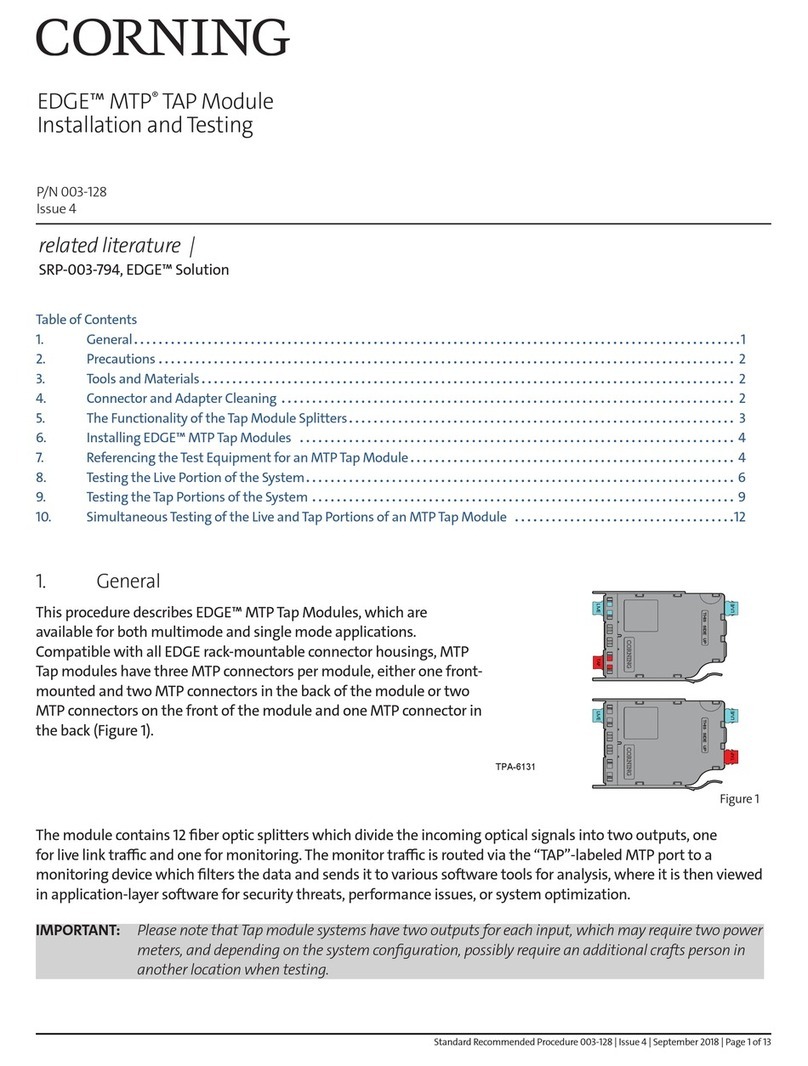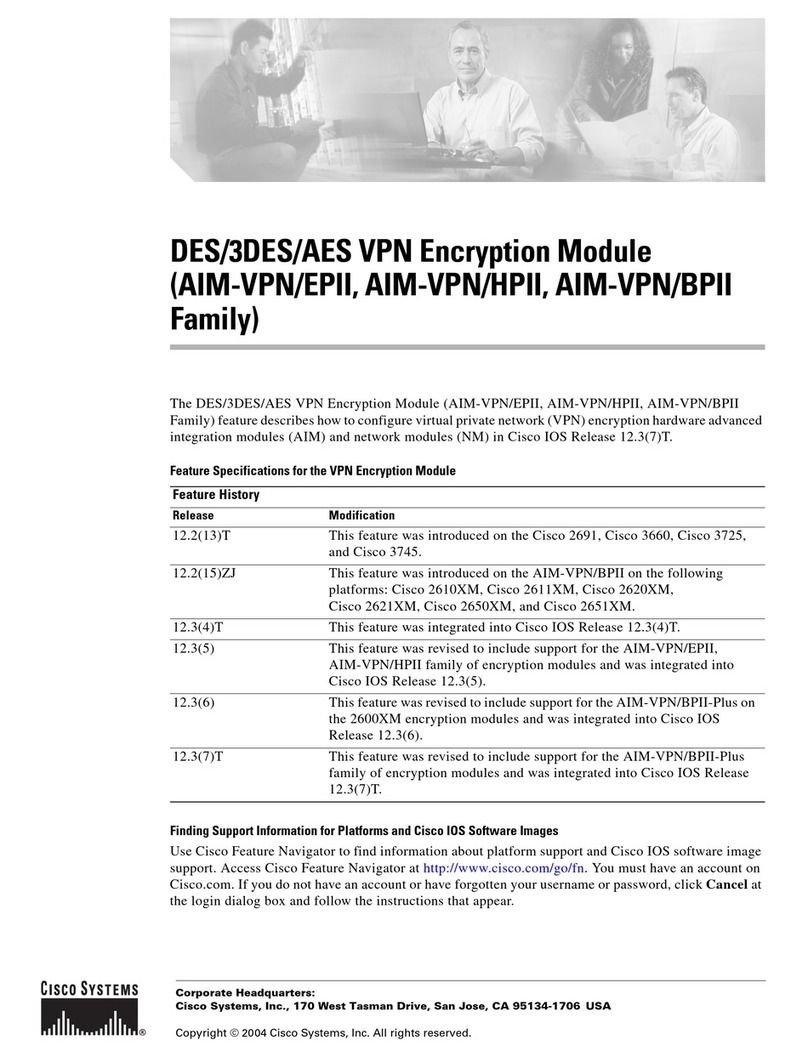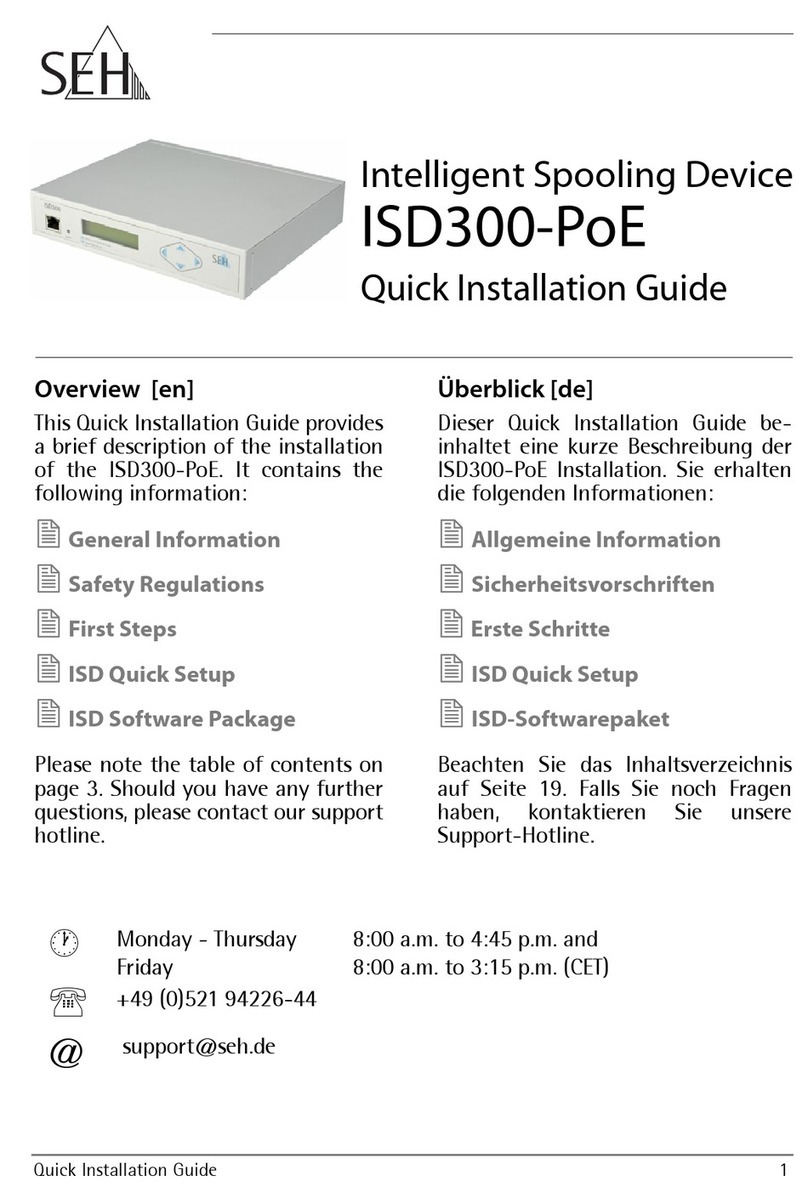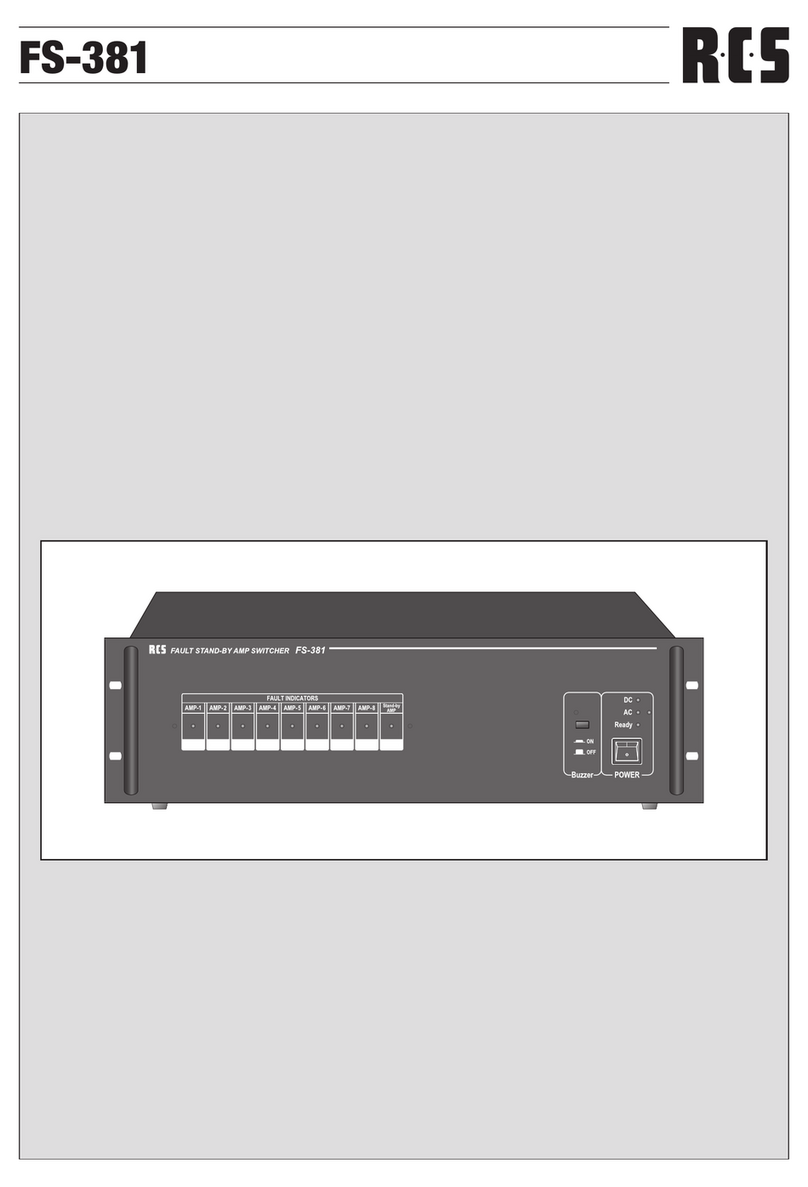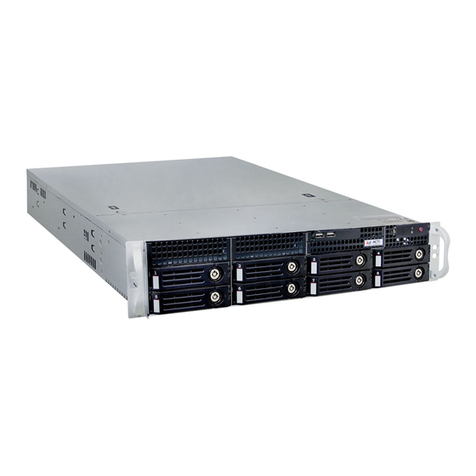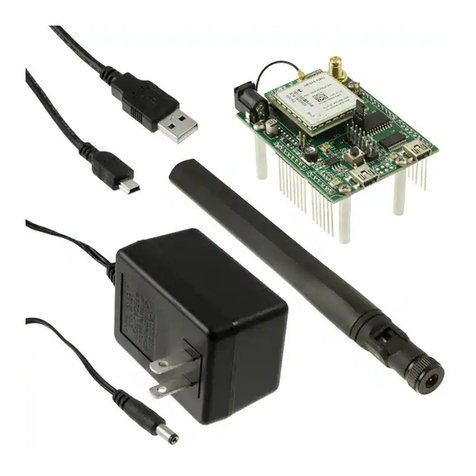netsys NV-1602S User manual

1
1
16
6
6
P
P
Po
o
or
r
rt
t
ts
s
s
V
V
VD
D
DS
S
SL
L
L2
2
2
M
M
Ma
a
an
n
na
a
ag
g
ge
e
ed
d
d
I
I
IP
P
P
D
D
DS
S
SL
L
LA
A
AM
M
M
w
w
wi
i
it
t
th
h
h
R
R
Re
e
ed
d
du
u
un
n
nd
d
da
a
an
n
nt
t
t
P
P
Po
o
ow
w
we
e
er
r
r
N
N
NV
V
V-
-
-1
1
16
6
60
0
02
2
2S
S
S
U
U
US
S
SE
E
ER
R
R
S
S
S
M
M
MA
A
AN
N
NU
U
UA
A
AL
L
L

NV-1602S 16 Ports VDSL2 Managed IP DSLAM with Redundant Power USER S MANUAL Ver.A2
1
Copyright
Copyright © 2011 by National Enhance Technology Corp. All rights reserved.
Trademarks
NETSYS is a trademar of National Enhance Technology Corp.
Other brand and product names are registered trademar s or trademar s of their respective holders.
Legal Disclaimer
The information given in this document shall in no event be regarded as a guarantee of conditions or characteristics. With respect
to any examples or hints given herein, any typical values stated herein and/or any information regarding the application of the
device, National Enhance Technology Corp. hereby disclaims any and all warranties and liabilities of any ind, including without
limitation warranties of non-infringement of intellectual property rights of any third party.
Statement of Conditions
In the interest of improving internal design, operational function, and/or reliability, NETSYS reserves the right to ma e changes to
the products described in this document without notice. NETSYS does not assume any liability that may occur due to the use or
application of the product(s) or circuit layout(s) described herein.
Maximum signal rate derived from IEEE Standard specifications. Actual data throughput will vary. Networ conditions and
environmental factors, including volume of networ traffic, building materials and construction, and networ overhead, lower actual
data throughput rate. Netsys does not warrant that the hardware will wor properly in all environments and applications, and
ma es no warranty and representation, either implied or expressed, with respect to the quality, performance, merchantability, or
fitness for a particular purpose. Ma e sure you follow in line with the environmental conditions to use this product.

NV-1602S 16 Ports VDSL2 Managed IP DSLAM with Redundant Power USER S MANUAL Ver.A2
2
Safety Warnings
For your safety, be sure to read and follow all warning notices and instructions before using the device.
DO NOT open the device or unit. Opening or removing the cover may expose you to dangerous high voltage points or other
ris s. ONLY qualified service personnel can service the device. Please contact your vendor for further information.
Use ONLY the dedicated power supply for your device. Connect the power to the right supply voltage (110V AC used for
North America and 230V AC used for Europe).
Place connecting cables carefully so that no one will step on them or stumble over them. DO NOT allow anything to rest on
the power cord and do NOT locate the product where anyone can wor on the power cord.
DO NOT install nor use your device during a thunderstorm. There may be a remote ris of electric shoc from lightning.
DO NOT expose your device to dampness, dust or corrosive liquids.
DO NOT use this product near water, for example, in a wet basement or near a swimming pool.
Connect ONLY suitable accessories to the device.
Make sure to connect the cables to the correct ports.
DO NOT obstruct the device ventilation slots, as insufficient air flow may harm your device.
DO NOT place items on the device.
DO NOT use the device for outdoor applications directly, and ma e sure all the connections are indoors or have waterproof
protection place.
Be careful when unplugging the power, because it may produce spar s.
Keep the device and all its parts and accessories out of the reach of children.
Clean the device using a soft and dry cloth rather than liquid or atomizers. Power off the equipment before cleaning it.
This product is recyclable. Dispose of it properly.

NV-1602S 16 Ports VDSL2 Managed IP DSLAM with Redundant Power USER S MANUAL Ver.A2
3
Attention:
Be sure to read this manual carefully before using this product. Especially Legal Disclaimer, Statement
of Conditions and Safety Warnings.
Caution:
The NV-1602S are for indoor applications only. This product does not have waterproof protection.
VDSL2 Brief
VDSL2 (Very-High-Bit-Rate Digital Subscriber Line 2, ITU-T G.993.2 Standard) is an access technology that exploits the existing
infrastructure of copper wires that were originally deployed for POTS services. It can be deployed from central offices, from fibre-fed
cabinets located near the customer premises, or within buildings.
ITU-T G.993.2 VDSL2 is the newest and most advanced standard of DSL broadband wireline communications. Designed to support
the wide deployment of Triple Play services such as voice, video, data, high definition television (HDTV) and interactive gaming,
VDSL2 enables operators and carriers to gradually, flexibly, and cost efficiently upgrade existing xDSL-infrastructure.
ITU-T G.993.2 (VDSL2) is an enhancement to G.993.1 VDSL that permits the transmission of asymmetric and symmetric
(Full-Duplex) aggregate data rates up to 200 Mbit/s on twisted pairs using a bandwidth up to 30 MHz.
VDSL2 deteriorates quic ly from a theoretical maximum of 200 Mbit/s at 'source' to symmetric 100 Mbit/s at 0.3 m and 50 Mbit/s at
1 m, but degrades at a much slower rate from there, and still outperforms VDSL. Starting from 1,6 m its performance is equal to
ADSL2+.
ADSL-li e long reach (LR) performance: ADSL-li e long reach performance is one of the ey advantages of VDSL2. LR-VDSL2
enabled systems are capable of supporting speeds of around 1-4 Mbit/s (downstream) over distances of 2.5 m, gradually
increasing the bit rate up to symmetric 100Mbit/s as loop-length shortens. This means that VDSL2-based systems, unli e VDSL1

NV-1602S 16 Ports VDSL2 Managed IP DSLAM with Redundant Power USER S MANUAL Ver.A2
4
systems, are not limited to short loops or MTU/MDUs only, but can also be used for medium range applications.
VDSL2 IP DSLAM
The NV-1602S utilize Lantiq(Infineon) Vinax VDSL2 Chipset, which is a VDSL2 IP DSLAM that aggregates 16 ports into Giga
Ethernet uplin s for high-speed data/Internet services.
Based on DMT VDSL2 technologies, NV-1602S extends data service with line rate of solution for services such as remote lecturing,
telemedicine, video conferencing, Video-on-Demand (VoD), IP-TV, Internet access and other various high-speed data applications.
When the number of subscribers increases, the second uplin Giga Ethernet interface can be used to daisy chain to another
NV-1602S. Alternatively, multiple NV-1602S can be connected to another LAN switch to from a two-tier configuration, thus
supporting a lot more subscribers. The NV-1602S is an ideal solution for delivering cost-effective, high-performance
broadband/multimedia services to Multi-Tenant Units (MTUs) or Multi-Dwelling Units (MDUs) such as hotels, campus, hospitals and
telecom.
The NV-1602S provides the important features necessary for robust networ s
Key features and benefits :
Jumbo packet up to 9k byte:
In computer networ ing, jumbo frames are Ethernet frames with more than 1500 bytes of
payload. Conventionally, jumbo frames can carry up to 9000 bytes of payload, but variations exist and some care must be
ta en when using the term.
The original 1500-byte payload size for Ethernet frames was used because of the high error rates and low speed of
communications. Thus, if one receives a corrupted pac et, only 1500 bytes (plus 18 bytes for the frame header and other
overhead) must be re-sent to correct the error. However, each frame requires that the networ hardware and software

NV-1602S 16 Ports VDSL2 Managed IP DSLAM with Redundant Power USER S MANUAL Ver.A2
5
process it. If the frame size is increased, the same amount of data can be transferred with less effort. This reduces CPU
utilization (mostly due to interrupt reduction) and increases throughput by allowing the system to concentrate on the data in
the frames.
IEEE 802.1q Q-in-Q VLAN for performance & security:
The VLAN feature in the switch offers the benefits of both security
and performance. VLAN is used to isolate traffic between different users and thus provides better security. Limiting the
broadcast traffic to within the same VLAN broadcast domain also enhances performance. VLAN support enabling advanced
techniques such as 802.1Q-in-1Q to be deployed.
And support GVRP up to 4 V-Lan groups.
IEEE 802.1x: port base networ access control, this function for wireless users connecting Authentication.
Spanning tree: Support IEEE 802.1d STP/IEEE 802.1w RSTP/IEEE-802.1s MSTP. For mission critical environments with
multiple switches supporting STP, you can configure the switches with a redundant bac up bridge path, so transmission and
reception of pac ets can be guaranteed in event of any fail-over switch on the networ .
IEEEE 802.1p QoS(COS) with Four Priority Queues:
The QoS(Quality Of Service) feature provides four internal queues to support four different classifications of
traffic. High priority pac et streams experience less delay inside the switch, which supports lower latency for
certain delay-sensitive traffic. The NV-1602S can classify the pac et as one of the 8-level priority to 4 –level
queue mapping. I.e. Highest, SecHigh, Lowest, SecLow.
Differentiated Services or DiffServ: is a computer networ ing architecture that specifies a simple, scalable and
coarse-grained mechanism for classifying, managing networ traffic and providing Quality of Service (QoS) on

NV-1602S 16 Ports VDSL2 Managed IP DSLAM with Redundant Power USER S MANUAL Ver.A2
6
modern IP networ s. DiffServ can, for example, be used to provide low-latency to critical networ traffic such as
voice or streaming media while providing simple best-effort service to non-critical services such as web traffic or
file transfers.
DiffServ uses the 6-bit Differentiated Services Code Point (DSCP) field in the IP header for pac et
classification purposes. DSCP replaces the outdated Type of Service field.
IGMP Snooping : Snooping by 256 IP multicast table for VOD (Video on demand) and Video conference and Internet games
application.
HTTPS (SSL) Web Access: Hypertext Transfer Protocol Secure (HTTPS) is a combination of the Hypertext Transfer
Protocol with the SSL protocol to provide encrypted communication and secure identification of a networ web
server. HTTPS connections are often used for payment transactions on the World Wide Web and for sensitive
transactions in corporate information systems.
SNMP MIB Support: SNMP v1/v2c/v3 management and trap function
Support MIB tables: MIB-II (RFC 1213), Bridge MIBs (RFC 1493), Ethernet-li e MIB (RFC 1643 & RFC 2665), private-MIB,
USM-MIB (RFC 2574), VACM-MIB (RFC 2575) and RMON-MIB 1, 2, 3, 9 groups (RFC 1757& RFC 2819).
Broadcast/Multicast/Unknown-unicast Storm Control: To limit too many broadcast/multicast/un nown-unicast flooding
in the networ , broadcast/multicast storm control is used to restrict excess traffic. Threshold values are available to control
the rate limit for each port. Pac ets are discarded if the count exceeds the configured upper threshold.
Port Mirroring: This function could be mirroring and duplicated client side action, but Need to be with mirroring AP as

NV-1602S 16 Ports VDSL2 Managed IP DSLAM with Redundant Power USER S MANUAL Ver.A2
7
Session wall or other.
ACL(Access Control List): On some types of proprietary computer hardware, an Access Control List refers to rules that
are applied to port numbers or networ daemon names that are available on a host or other layer 3, each with a list of hosts
and/or networ s permitted to use the service. Both individual servers as well as routers can have networ ACLs. Access
control lists can generally be configured to control both inbound and outbound traffic, and in this context they are similar to
firewalls. Li e Firewalls, ACLs are subject to security regulations and standards.
Link Layer Discovery Protocol (LLDP): is a vendor-neutral Lin Layer protocol in the Internet Protocol Suite used by
networ devices for advertising their identity, capabilities, and neighbors on a IEEE 802 local area networ , principally wired
Ethernet. The protocol is formally referred to by the IEEE as Station and Media Access Control Connectivity Discovery
specified in standards document IEEE 802.1AB.
Speed Rate Control(Traffic shaping): Supports speed rate control function from 128 to 100Mbps.
Note:
Regarding our NV-1602S' principle of bandwidth control, which must rely on flow control to limit bandwidth over
hardware, as long as client side doesn't support flow control, the upstream bandwidth control is invalid, so for this
case, client side must support flow control function.
In band Management: Provides a console(RS232) port for setup IP or other function
Out Of Band Management: Supports remote control by Web-based Management easy-to-use configuration and ongoing
monitoring. This software is embedded in the switch and delivers remote, intuitive management of the switch and connected
NIC devices through a single IP address. The NV-1602S are easy-to-configured and deployed, and offering a compelling

NV-1602S 16 Ports VDSL2 Managed IP DSLAM with Redundant Power USER S MANUAL Ver.A2
8
option in terms of cost, performance, scalability and services compared to traditional repeater HUB solutions.
2 Dual Media for Flexible Fiber Connection:Dual media port 9 and 10 are provided for flexible fiber/copper auto lin
connection. You can select to install optional transceiver modules in these slots for short, medium or long distance fiber
bac bone attachment. Use of the SFP will auto disable their corresponding built-in 10/100/1000Base-T connections.
DHCP Client: Dynamic Host Configuration Protocol (DHCP) for auto configuration management IP.
TFTP Protocol: Trivial File Transfer Protocol(TFTP) for new version firmware remote upgraded
Firmware upgrade support : HTTP / TFTP protocol.
Scalability: Up to 100 Mbps symmetric performance over single-pair wiring for VDSL2 Channel.
Interleave delay time: To prevent the transmission against burst errors. Please note that enable interleave delay
function will reduce a few vdsl2 bandwidth.
Noise Margin(SNRM): In electrical engineering, noise margin is the amount by which a signal exceeds the minimum
amount for proper operation. NV-1602S default value is 6db for telecom standard.
Upstream Power Back-Off (UPBO): helps to run services over loops with
different length co-located in the same cable
binder (“mixed length” deployments), especially in FEXT-dominated noise environment.
Strong FEXT generated by short loops can significantly degrade the performance of long loops if UPBO is not applied.

NV-1602S 16 Ports VDSL2 Managed IP DSLAM with Redundant Power USER S MANUAL Ver.A2
9
On the other hand, UPBO reduces the transmit power of short loops and thus degrades their performance as well.
The UPBO technique should ta e in account both issues.
Downstream Power Back-Off (DPBO):
The development of Triple Play services requires higher bandwidth. Higher
bandwidth and substantial performance gain can be reached by deploying DSLAM-s in a remote side cabinet near to the
customer premises. There is no problem at clean networ s where all the customers are connected to the same local
cabinet.
Trellis coding : The name trellis was coined because a state diagram of the technique, when drawn on paper closely
resembles the trellis lattice used in rose gardens. The scheme is basically a convolutional code of rates (r,r+1).
Ungerboec 's unique contribution is to apply the parity chec on a per symbol basis instead of the older technique of
applying it to the bit stream then modulating the bits. The ey idea he termed Mapping by Set Partitions. This idea was to
group the symbols in a tree li e fashion then separate them into two limbs of equal size. At each limb of the tree, the
symbols were further apart. Although in multi-dimensions, it is hard to visualize, a simple one dimension example illustrates
the basic procedure. Suppose the symbols are located at [1, 2, 3, 4, ...]. Then ta e all odd symbols and place them in one
group, and the even symbols in the second group. This is not quite accurate because Ungerboec was loo ing at the two
dimensional problem, but the principle is the same, ta e every other one for each group and repeat the procedure for each
tree limb. He next described a method of assigning the encoded bit stream onto the symbols in a very systematic procedure.
Once this procedure was fully described, his next step was to program the algorithms into a computer and let the computer
search for the best codes. The results were astonishing. Even the most simple code (4 state) produced error rates nearly
1,000 times lower than an equivalent uncoded system. For two years Ungerboec ept these results private and only
conveyed them to close colleagues. Finally, in 1982, Ungerboec published a paper describing the principles of trellis
modulation.

NV-1602S 16 Ports VDSL2 Managed IP DSLAM with Redundant Power USER S MANUAL Ver.A2
10
A flurry of research activity ensued, and by 1990 the International Telecommunication Union had published modem
standards for the first trellis-modulated modem at 14.4 bit/s (2,400 baud and 6 bits per symbol). Over the next several years
further advances in encoding, plus a corresponding symbol rate increase from 2,400 to 3,429 baud, allowed modems to
achieve rates up to 34.3 bit/s (limited by maximum power regulations to 33.8 bit/s). Today, the most common
trellis-modulated V.34 modems use a 4-dimensional set partition which is achieved by treating two 2-dimensional symbols as a
single lattice. This set uses 8, 16, or 32 state convolutional codes to squeeze the equivalent of 6 to 10 bits into each symbol
sent by the modem (for example, 2,400 baud × 8 bits/symbol = 19,200 bit/s).
Once manufacturers introduced modems with trellis modulation, transmission rates increased to the point where interactive
transfer of multimedia over the telephone became feasible (a 200 ilobyte image and a 5 megabyte song could be downloaded
in less than 1 minute and 30 minutes, respectively). Sharing a floppy dis via a BBS could be done in just a few minutes,
instead of an hour. Thus Ungerboec 's
Echo cancellation : The term echo cancellation is used in telephony to describe the process of removing echo from a voice
communication in order to improve voice quality on a telephone call. In addition to improving subjective quality, this process
increases the capacity achieved through silence suppression by preventing echo from traveling across a networ .
Two sources of echo have primary relevance in telephony: acoustic echo and hybrid echo.
Echo cancellation involves first recognizing the originally transmitted signal that re-appears, with some delay, in the transmitted
or received signal. Once the echo is recognized, it can be removed by 'subtracting' it from the transmitted or received signal.
This technique is generally implemented using a digital signal processor (DSP), but can also be implemented in software. Echo
cancellation is done using either echo suppressors or echo cancellers, or in some cases both.
INP(Impulse Noise Protection): Impulse noise in multicarrier communication systems behaves effectively as a modulating

NV-1602S 16 Ports VDSL2 Managed IP DSLAM with Redundant Power USER S MANUAL Ver.A2
11
signal that controls the first moment of the bac ground Gaussian noise. The composite noise, which is the aggregate of the
Gaussian noise and impulse noise, has a probability density function that is conditionally Gaussian with non-zero average,
hence referred to as biased-Gaussian. The BER-equivalent power of the composite noise source is defined as the power of a
pure Gaussian noise source that yields the same bit-error rate (BER). The BER-equivalent noise for a biased-Gaussian noise
is simply the amplified version of the underlying Gaussian noise source. The amplification factor is derived from the
characteristics of the impulse interference. Any bit-loading algorithm designed for Gaussian noise sources is also applicable to
biased-Gaussian noise sources provided that the BER-equivalent SNR is used in place of the measured SNR.
Syslog : is a standard for logging program messages. It allows separation of the software that generates messages from the
system that stores them and the software that reports and analyzes them. It also provides devices which would otherwise be
unable to communicate a means to notify administrators of problems or performance.
Syslog can be used for computer system management and security auditing as well as generalized informational, analysis,
and debugging messages. It is supported by a wide variety of devices (li e printers and routers) and receivers across multiple
platforms. Because of this, syslog can be used to integrate log data from many different types of systems into a central
repository.

NV-1602S 16 Ports VDSL2 Managed IP DSLAM with Redundant Power USER S MANUAL Ver.A2
12
Table of Contents
Copyright.............................................................................................................................................................1
Safety Warnings..................................................................................................................................................2
VDSL2 Brief .........................................................................................................................................................3
VDSL2 IP DSLAM ................................................................................................................................................4
Chapter 1. Unpacking Information...................................................................................................................19
1.1 Check list ............................................................................................................................................................................ 19
1.2 Package Contents .............................................................................................................................................................. 19
1.3 Product Guide .................................................................................................................................................................... 20
1.4 Features & Specifications ................................................................................................................................................. 20
1.5 Product Specification ........................................................................................................................................................ 23
Chapter 2. General Description .......................................................................................................................24
2.1 Hardware Description ........................................................................................................................................................ 24
2.2 Front Panel ......................................................................................................................................................................... 24
2.3 SFP Fiber Optics ................................................................................................................................................................ 26
2.5 Rear Panel........................................................................................................................................................................... 28
2.6 AC Power Socket ............................................................................................................................................................... 28
2.7 DC Power Socket ............................................................................................................................................................... 29
Chapter 3. Installation ......................................................................................................................................30

NV-1602S 16 Ports VDSL2 Managed IP DSLAM with Redundant Power USER S MANUAL Ver.A2
13
3.1 Hardware Installation......................................................................................................................................................... 30
3.2 Pre-Installation Requirements .......................................................................................................................................... 30
3.3 General Rules ..................................................................................................................................................................... 31
3.4 Connection Configuration ................................................................................................................................................. 32
3.5 Mounting the Switch on a Rack ........................................................................................................................................ 33
Chapter 4. Management Configuration ...........................................................................................................34
4.0 In-Band Management......................................................................................................................................................... 34
4.0.1 Operation Notice ...................................................................................................................................................... 37
4.0.1.0 Command Line Editing.................................................................................................................................. 37
4.0.1.1 Command Help............................................................................................................................................... 38
4.0.1.2 Upgrade firmware via console command line............................................................................................. 38
4.0.1.3 Reset system to default via console command line ................................................................................... 39
4.0.2 System Commands.................................................................................................................................................. 40
4.0.3 Switch Static Configuration .................................................................................................................................... 41
4.0.3.0 Port Configuration and Status ...................................................................................................................... 41
4.0.3.1 VLAN ............................................................................................................................................................... 44
4.0.3.2 Misc Configuration ........................................................................................................................................ 58
4.0.3.3 Administration................................................................................................................................................ 60
4.0.3.4 Port Mirroring ................................................................................................................................................. 61
4.0.3.5 Quality of Service........................................................................................................................................... 62
4.0.3.6 MAC Address Table ....................................................................................................................................... 65
4.0.3.7 MAC Limit ....................................................................................................................................................... 67

NV-1602S 16 Ports VDSL2 Managed IP DSLAM with Redundant Power USER S MANUAL Ver.A2
14
4.0.4 Protocol Related Configuration .............................................................................................................................. 69
4.0.4.0 STP/RSTP ....................................................................................................................................................... 69
4.0.4.1 MSTP............................................................................................................................................................... 73
4.0.4.2 SNMP .............................................................................................................................................................. 80
4.0.4.3 IGMP................................................................................................................................................................ 87
4.0.4.4 802.1x.............................................................................................................................................................. 88
4.0.4.5 DHCP Relay & Option 82 ............................................................................................................................... 91
4.0.4.6 LLDP ............................................................................................................................................................... 95
4.0.5 Syslog ..................................................................................................................................................................... 100
4.0.6 Reboot switch ........................................................................................................................................................ 100
4.0.6.0 Reset to Default............................................................................................................................................ 100
4.0.6.1 Restart .......................................................................................................................................................... 100
4.0.7 TFTP Function........................................................................................................................................................ 100
4.0.7.0 TFTP Firmware Update................................................................................................................................ 100
4.0.7.1 Restore Configure File ................................................................................................................................ 101
4.0.7.2 Backup Configure File................................................................................................................................. 101
4.0.8 Access Control List ............................................................................................................................................... 102
4.0.8.0 IPv4 ACL commands ................................................................................................................................... 102
4.0.8.1 Non-IPv4 ACL commands ........................................................................................................................... 105
4.0.8.2 SIP/SMAC Binding ....................................................................................................................................... 106
4.1 Remote Network Management ........................................................................................................................................ 108
4.2 Administration.................................................................................................................................................................. 110
4.2.0 IP Address Setting .................................................................................................................................................. 111

NV-1602S 16 Ports VDSL2 Managed IP DSLAM with Redundant Power USER S MANUAL Ver.A2
15
4.2.1 Switch Setting .........................................................................................................................................................112
4.2.1.0 Basic ..............................................................................................................................................................112
4.2.1.1 Module Info....................................................................................................................................................113
4.2.1.2 MISC CONFIG ................................................................................................................................................114
4.2.2 Console Port Information .......................................................................................................................................116
4.2.3 Port Configuration ..................................................................................................................................................117
4.2.3.0 Port Controls .................................................................................................................................................117
4.2.3.1 Port Sniffer ....................................................................................................................................................119
4.2.3.2 Protected Port .............................................................................................................................................. 122
4.2.4 SNMP Configuration .............................................................................................................................................. 123
4.2.4.0 System Options............................................................................................................................................ 123
4.2.4.1 Community strings ...................................................................................................................................... 124
4.2.4.2 Trap Manager ............................................................................................................................................... 124
4.2.4.3 SNMPv3 Group............................................................................................................................................. 125
4.2.4.4 SNMPv3 View ............................................................................................................................................... 126
4.2.4.5 SNMPV3 ACCESS ........................................................................................................................................ 127
4.2.4.6 SNMPv3 USM-User ...................................................................................................................................... 128
4.2.5 Syslog ..................................................................................................................................................................... 129
4.2.6 Firmware Update.................................................................................................................................................... 131
4.2.6.0 TFTP Update................................................................................................................................................. 131
4.2.6.1 HTTP Update ................................................................................................................................................ 133
4.2.7 Configuration Backup............................................................................................................................................ 134
4.2.7.0 TFTP Restore Configuration ....................................................................................................................... 134

NV-1602S 16 Ports VDSL2 Managed IP DSLAM with Redundant Power USER S MANUAL Ver.A2
16
4.2.7.1 TFTP Backup Configuration........................................................................................................................ 134
4.3 L2 Features ....................................................................................................................................................................... 136
4.3.0 VLAN Configuration............................................................................................................................................... 137
4.3.0.0 Static VLAN .................................................................................................................................................. 138
4.3.0.1 GVRP VLAN.................................................................................................................................................. 144
4.3.0.2 QinQ VLAN ................................................................................................................................................... 145
4.3.1 Forwarding and Filtering ....................................................................................................................................... 148
4.3.1.0 Dynamic MAC Address ............................................................................................................................... 149
4.3.1.1 Static MAC Table.......................................................................................................................................... 150
4.3.1.2 MAC Filtering................................................................................................................................................ 152
4.3.2 IGMP Snooping ...................................................................................................................................................... 153
4.3.3 Spanning Tree ........................................................................................................................................................ 155
4.3.3.0 STP system................................................................................................................................................... 155
4.3.3.1 MSTP system................................................................................................................................................ 160
4.3.4 DHCP Relay and Option 82 ................................................................................................................................... 166
4.3.4.0DHCP Option82 ............................................................................................................................................. 166
4.3.4.1 DHCP Relay .................................................................................................................................................. 167
4.3.5 LLDP........................................................................................................................................................................ 168
4.3.5.0 LLDP Configuration ..................................................................................................................................... 168
4.3.5.1 PerPort Configuration ................................................................................................................................. 169
4.4 Access Control List ......................................................................................................................................................... 171
4.4.0 IPv4.......................................................................................................................................................................... 173
4.4.1 Non-IPv4 ................................................................................................................................................................. 179

NV-1602S 16 Ports VDSL2 Managed IP DSLAM with Redundant Power USER S MANUAL Ver.A2
17
4.4.2 Binding.................................................................................................................................................................... 181
4.4.3 QoS VoIP................................................................................................................................................................. 183
4.5 Security............................................................................................................................................................................. 185
4.5.0 Security Manager ................................................................................................................................................... 185
4.5.1 MAC Limit ............................................................................................................................................................... 186
4.5.2 802.1x Configuration.............................................................................................................................................. 187
4.5.2.0 System Configuration.................................................................................................................................. 188
4.5.2.1 Perport Configuration.................................................................................................................................. 189
4.5.2.2 Misc Configuration ...................................................................................................................................... 190
4.6 QoS.................................................................................................................................................................................... 192
4.6.0 QoS Configuration ................................................................................................................................................. 192
4.6.1 Per-Port Configuration .......................................................................................................................................... 194
4.6.2 ToS/DSCP Configuration....................................................................................................................................... 196
4.7 Monitoring......................................................................................................................................................................... 200
4.7.0 Port Status.............................................................................................................................................................. 200
4.7.1 Port Statistics......................................................................................................................................................... 202
4.8 Reset System.................................................................................................................................................................... 203
4.9 Reboot............................................................................................................................................................................... 203
Chapter 5. VDSL2 functions...........................................................................................................................204
5.1 Profile Config.................................................................................................................................................................... 204
5.2 Channel Config................................................................................................................................................................. 211
5.3 Channel Status ................................................................................................................................................................. 214

NV-1602S 16 Ports VDSL2 Managed IP DSLAM with Redundant Power USER S MANUAL Ver.A2
18
5.4 SNR Status........................................................................................................................................................................ 215
5.5 Activate / Deactivate ........................................................................................................................................................ 216
5.7 UPBO................................................................................................................................................................................. 221
5.8 Trellis Config .................................................................................................................................................................... 224
5.9 VDSL2 Version Info.......................................................................................................................................................... 225
5.10 VDSL2 Location Info. ..................................................................................................................................................... 226
Chapter 6. Applications.................................................................................................................................. 227
Appendix A: Troubleshooting........................................................................................................................230
Appendix B: Example of VLAN Setting .........................................................................................................236
Example 1: .............................................................................................................................................................................. 236
Example 2: .............................................................................................................................................................................. 240
Example 3: .............................................................................................................................................................................. 243
Appendix C: Cable Requirements .................................................................................................................247
Appendix D: Compliance and Safety Information ........................................................................................250
Warranty .......................................................................................................................................................... 254
Chinese SJ/T 11364-2006 ...............................................................................................................................255

NV-1602S 16 Ports VDSL2 Managed IP DSLAM with Redundant Power USER S MANUAL Ver.A2
19
Chapter 1.
Unpacking Information
1.1 Check list
Carefully unpac the pac age and chec its contents against the chec list.
1.2 Package Contents
1. NV-1602S Managed VDSL2 IP DSLAM
16 x VDSL2 Ports(RJ45),2 x RJ-45 Gigabit TP / SFP combo port
2. 1 x QR code for user’s manual hyperlin
3. 1x AC Power Cord
4. A pac age contains two Rac Mounting Brac ets, eight screws and 5pin terminal bloc .
5. 4x Plastic feet(Pre-installed on the bottom)
Notes:
1. Please inform your dealer immediately for any missing or damaged parts. If possible, retain the carton including the
original pac ing materials. Use them to repac the unit in case there is a need to return for repair.
2. If the product has any issue, please contact your local distributor.
3. Please loo for the QR code on the bottom of the product, the user can launch the QR code scanning program to
scan and download the user’s manual electronic format file.
Table of contents
Other netsys Network Hardware manuals
Popular Network Hardware manuals by other brands
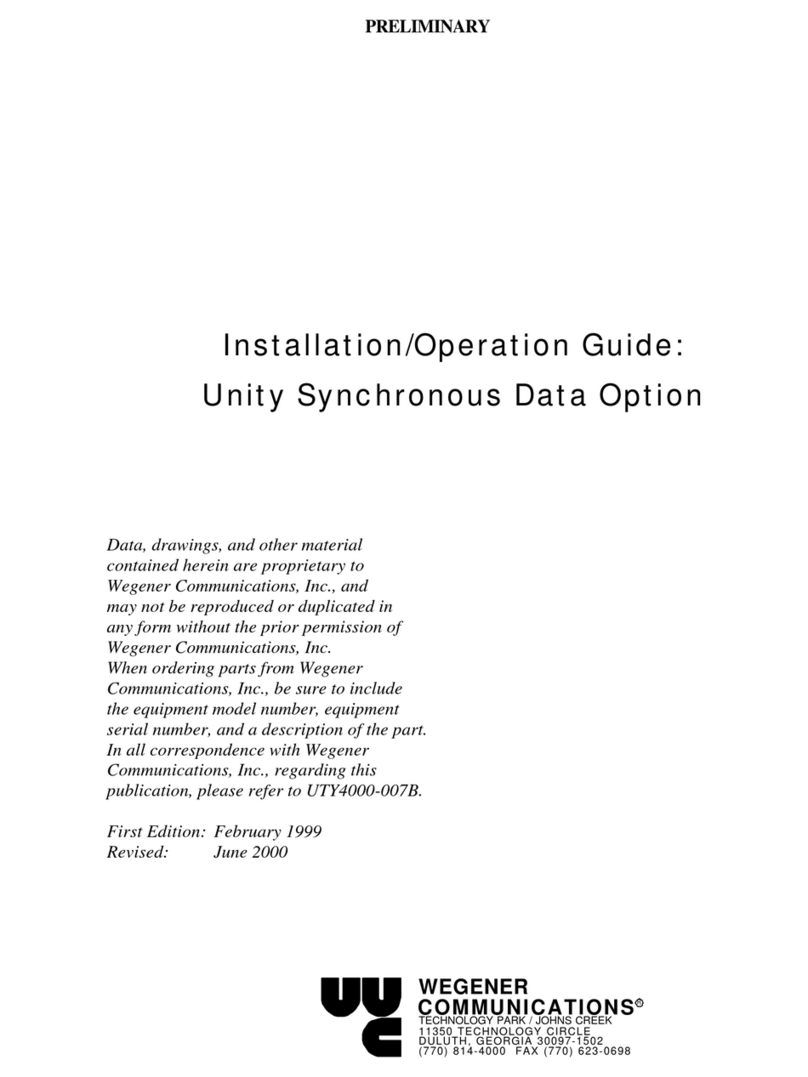
Wegener
Wegener Unity Satellite Receiver Model Unity Synchronous Data... Installation & operation
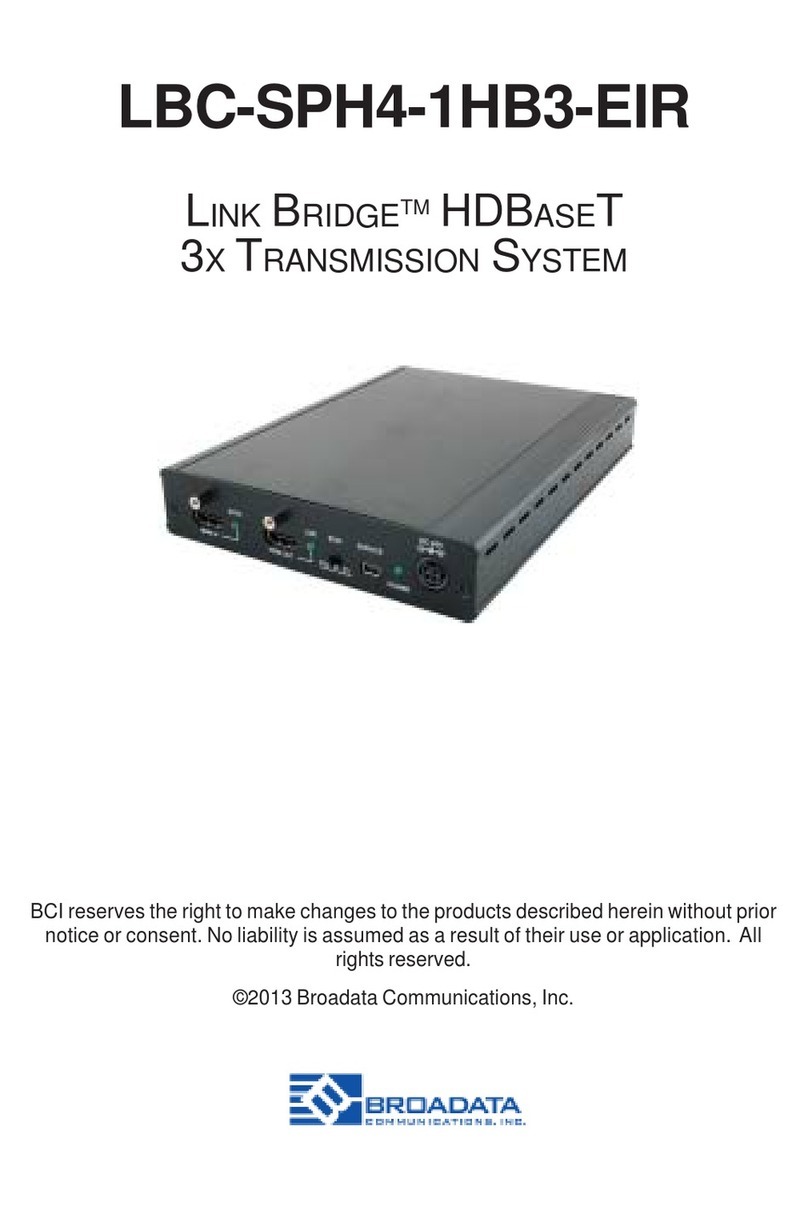
Broadata
Broadata LBC-SPH4-1H3B-EIR user manual

Emerson
Emerson Bristol Helicoid Gauges Product overview
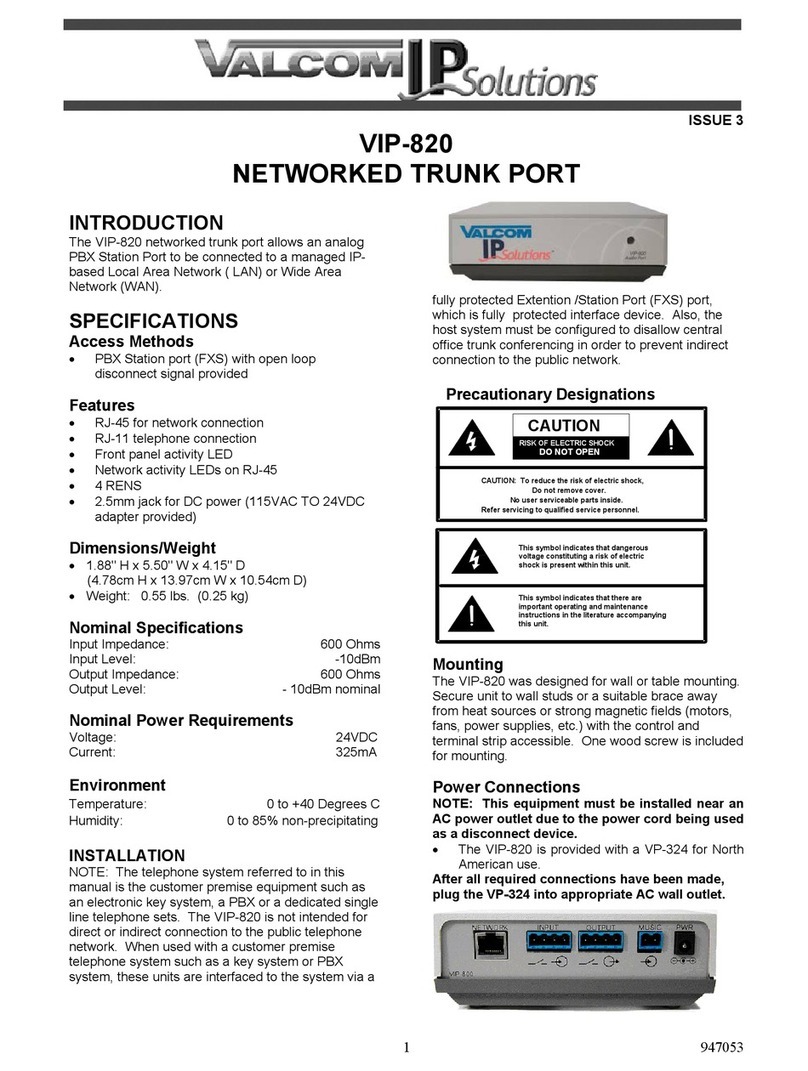
Valcom
Valcom IP Solutions VIP-820 user guide

Amphenol
Amphenol HYP-3048 user guide
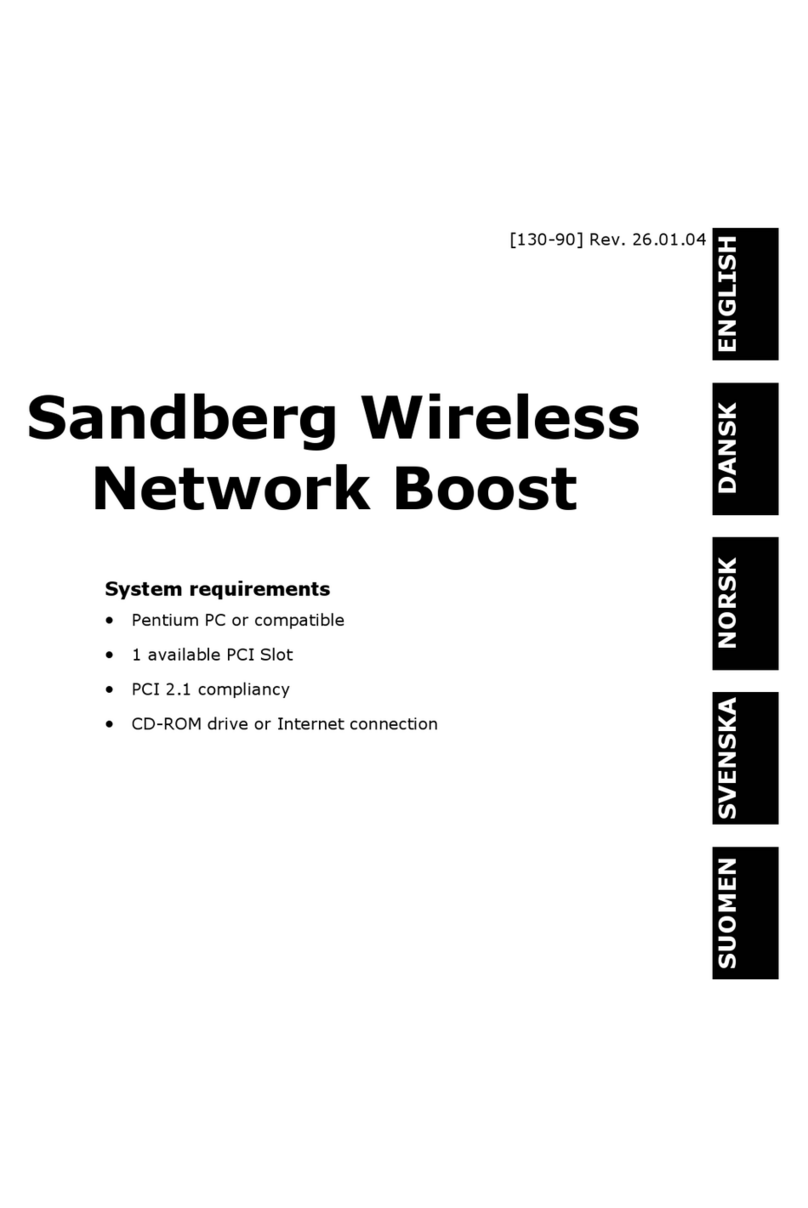
Sandberg
Sandberg 130-90 manual

